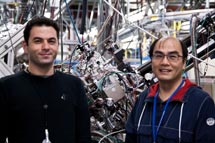
Handy Links
SLAC News Center
SLAC Today
- Subscribe
- Archives: Feb 2006-May 20, 2011
- Archives: May 23, 2011 and later
- Submit Feedback or Story Ideas
- About SLAC Today
SLAC News
Lab News
- Interactions
- Lightsources.org
- ILC NewsLine
- Int'l Science Grid This Week
- Fermilab Today
- Berkeley Lab News
- @brookhaven TODAY
- DOE Pulse
- CERN Courier
- DESY inForm
- US / LHC
SLAC Links
- Emergency
- Safety
- Policy Repository
- Site Entry Form

- Site Maps
- M & O Review
- Computing Status & Calendar
- SLAC Colloquium
- SLACspeak
- SLACspace
- SLAC Logo
- Café Menu
- Flea Market
- Web E-mail
- Marguerite Shuttle
- Discount Commuter Passes
-
Award Reporting Form
- SPIRES
- SciDoc
- Activity Groups
- Library
Stanford
Around the Bay
New SSRL Instruments Zoom In on Surfaces
Two new, state-of-the-art spectroscopy instruments at the Stanford Synchrotron Radiation Lightsource promise to give researchers both a broader and a deeper understanding of what happens during chemical reactions at the surfaces of materials. The first new endstation will enable experiments to take place in conditions that more closely mimic real-world conditions; the second will provide a closer look at the chemical bonds that form. The instruments—the Ambient Pressure Photoemission Spectroscopy Endstation, or APPES, and the Surface Science Endstation, or SSE—are being commissioned on SSRL Beamline 13-2.
"Ambient pressure" is the key to the APPES's capabilities. The instrument uses X-rays to knock electrons off the surface of a material in a process called photoemission spectroscopy, a fairly common technique in surface characterization. Where the APPES differs is its ability to reliably capture data from a material under a few tenths of an atmosphere of pressure. Previously, photoemission spectroscopy required ultra-high vacuum conditions so that the liberated electrons would not be scattered away by atoms in the surrounding atmosphere.
"But a surface in a vacuum is a static surface," said Hirohito Ogasawara, the SSRL staff scientist who, along with SSRL research associate Sarp Kaya, has been busy getting the instruments up and running. When the goal is to learn about surface chemistry, a static surface is a definite handicap, he said.
"With some pressure, you can look at actual processes," Kaya added, "more realistic events." These events all add up to the chemical state of a material's surface under complex conditions— for example, how the atoms and molecules in the surrounding atmosphere might affect the ability of a catalyst to do its job.
In contrast, the SSE requires what are called ideal conditions: a high vacuum and a tightly controlled environment. In return, researchers get a look at how molecules bond at an interface between two substances.
"We're looking at the interaction of molecules with catalytically reactive surfaces," Kaya explained.
"The two instruments are very complementary," said Anders Nilsson, deputy director of SUNCAT, and will prove valuable not only for research into catalysts—the province of SUNCAT—but surface science research in general.
The SSE has already seen use, but recent upgrades have extended its reach. "It's been rebuilt to make it fit in the [Linac Coherent Light Source]," in addition to SSRL, Ogasawara said. According to Ogasawara, the extremely short, intense pulses of X-ray laser light from LCLS enable experimenters to watch bonds form and break at timescales of less than one trillionth of a second, while at SSRL they're restricted to imaging static bonds.
As for the APPES instrument, the total number of such instruments available worldwide can be counted on the fingers of one hand, so the new APPES at Beamline 13-2 provides unique capabilities to the research community. Ogasawara and Kaya also tweaked the design to make the SLAC APPES instrument even better.
"We decided to go to pressures that are significantly higher than at other facilities with similar instruments, said Ogasawara. "We wanted to push the limits."
—by Lori Ann White
SLAC Today, January 20, 2011
